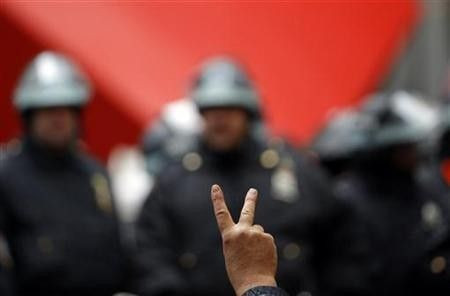Consensus, Human Mic Become Part of 'Occupy' Culture

When police ordered anti-Wall Street protesters out of a vacant lot in Oakland this week, the group responded as it does to nearly every challenge it has faced -- with a lively debate.
Mic check! shouted someone in the crowd. Mic check! a dozen voices called back. The group then proceeded to discuss whether it should comply with the police demand, with listeners repeating every word uttered by each speaker.
Such call-and-response meetings have become the signature of the Occupy Wall Street movement, which launched itself in September to demonstrate against economic inequality and excesses of the U.S. financial system.
The unique form of public address, along with elaborate rules for consensus decision-making, illustrates how deeply the movement is committed to living out its egalitarian ideals.
I think it could turn America on its head, said Kanene Holder, a member of the Occupy Wall Street facilitation group. It's such a beautiful thing if people do understand each other and hear each other's voices.
But unpleasant realities sometimes threaten these attempts to create utopian examples for the rest of society. At the same time that Occupy Wall Street was struggling to keep from being evicted from Zuccotti Park in New York, the group was carrying out its own evictions of unwelcome campers.
Maybe every three or four days someone would get kicked out, said Michael P. Pellagatti, a financial firm concierge who spent most of his free time there until police ejected all the campers on November 15.
Occupy San Francisco has also thrown out campers who became violent or disruptive, frequent visitor Carlos Saavedra said. In both camps, security committees hustled out the pariahs without pausing to take votes, he said.
Consensus decision-making is a work in progress that started long before Occupy Wall Street, said Francesca Polletta, a professor of sociology at the University of California at Irvine.
She traced its origins in American activism to Quakers who practiced consensus decision-making for three centuries, then shared their process with the civil rights movement after World War Two.
The Student Nonviolent Coordinating Committee fighting segregation in the South adopted consensus decision-making in part because Southerners in the group feared that Northerners would use parliamentary maneuvers to dominate, and partly because some decisions involved physical risk, she said.
WIGGLING FINGERS
You couldn't ask people to put their bodies on the line unless they agreed to it, said Polletta,
From the civil rights movement, consensus decision-making spread to other leftist causes.
It was embraced by Students for a Democratic Society in the 1960s. Feminists and anti-nuclear weapons campaigners and environmentalists adopted consensus principles in the 1970s and 1980s, and anti-globalists took it up in the 1990s.
At its best, scholars and participants both say, making decisions by consensus is more truly democratic than voting by a simple majority because more people can make themselves heard, and minorities are less likely to be shunted aside.
At its worst, the process is time-consuming and inefficient, allowing a few people to hold up the entire group on even a minor point.
Fundamental differences cannot be resolved, said Polletta, who is author of the book Freedom is an Endless Meeting: Democracy in American Social Movements.
Drawbacks of consensus decision-making became apparent in the student movements of the 1960s, said New York University professor Robert Cohen, who researches student activism.
They would meet and meet until they had consensus, and people would fall asleep at whoever's house they were meeting at. Sometimes the debaters with the most stamina prevailed.
The detailed structure put in place by the Occupy groups derive from efforts by various activists in the 1980s to address these flaws, said Polletta.
The groups use modified consensus in which motions can pass by 80 or 90 percent instead of the unanimity required in a pure consensus.
Facilitators also try to monitor the vibe of the group and make sure that no one is feeling excluded. They might say things like, 'I've noticed that only men have made comments for the last 20 minutes,' said Polletta.
Listeners indicate approval by wiggling fingers upward or displeasure by wiggling fingers downward. They urge the speaker to wrap up by making a rolling motion with their arms.
Final authority rests in a meeting of the whole group, referred to as a general assembly. But proposals originate in committees, and general assembly meetings frequently break up into discussion groups to give everyone a chance to comment. Anyone present can offer an amendment to each proposal.
The human mic may be an original contribution of the Occupy Movement, though some say it originated with the Black Panthers, a black nationalist group, in the 1970s.
It can border on absurdity: In one Occupy Oakland meeting when a speaker said that he had forgotten his notes.
Excuse me, I forgot my notes, the crowd parroted back.
The consensus philosophy also correlates with the movement's reluctance to appoint leaders or issue detailed policy statements.
Leaders and policies can both be co-opted, said Vasquez, and it is better to set an example.
It's about building alternative institutions while toppling the old ones, he said. We don't want to end the movement with legislation, we want to create a better world.
© Copyright Thomson Reuters {{Year}}. All rights reserved.





















